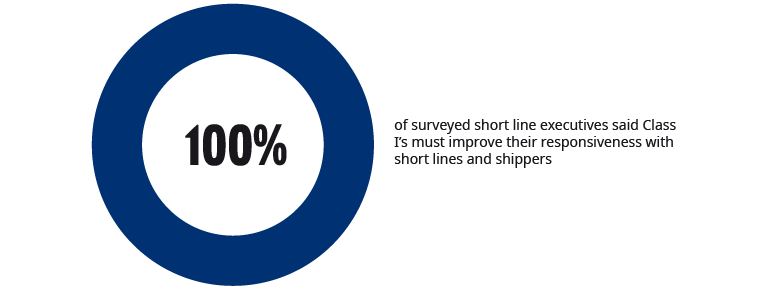Despite strong financial results and improved productivity, the North American Class I rail industry is experiencing slower volume growth and eroding market share. As we discussed in prior articles in this series, railroads need to develop a radical focus on growth to ensure long-term shareholder value, such as by converting more freight to intermodal and doubling down on scheduled railroading.
At the same time, many short line railroads are growing volumes, with some reporting double-digit traffic increases year-over-year. With a strong customer-first culture, short line railroads have realized impressive growth in recent years by leveraging infrastructure, providing ancillary services, and attracting industrial development.
In our report, "Unleash The Short Lines," we interviewed executives representing more than 300 North American short line railroads to find out what they see as the keys to short line success, as well as opportunities to partner with the Class I’s to better serve today’s shippers and supply chains — thereby reinvigorating rail’s role in the freight economy.
Making tracks to short line growth success
Across the board, short line executives highlighted four key steps for successful short line growth. First, most cited developing a culture of service and a passion for growth as critical factors. These leaders also said they focus on working collaboratively with partners to build full commercial solutions that can help customers have a more “truck-like” experience.
Next, successful short lines concentrate on understanding the businesses of their customers in detail to build strong relationships and optimize service levels. Using existing infrastructure, short lines are establishing or collaborating with transload facilities to bring additional freight to their lines.
Third, these short lines round out their offering with an array of ancillary services, such as intraplant switching, custom trackwork, railcar storage and cleaning, and door-to-door logistics. These not only provide additional revenue streams but are critical to meet the needs of today’s shippers — who increasingly are looking for integrated solutions rather than just an origin-to-destination move.
Finally, short lines are investing in new infrastructure, particularly to capitalize on growing demand for smaller-scale industrial and logistics hubs co-located with transportation options to maximize freight throughput and efficiency.
Unlocking the next level in short line growth
Short line leaders universally believe that more growth could be realized if Class I’s and short lines could evolve their ways of working together. There was consensus from our survey participants that greater focus by Class I’s in two specific areas could substantially grow the rail carload business: embracing a more strategic view of short lines and improving process responsiveness and collaboration.

Prioritizing short line strategy
Today, much of the coordination between Class I’s and connecting short lines is done by personnel at the local level, leading to uneven operations performance. We believe that Class I’s could drive more volume from their short line connections by developing an explicit short line strategy as a priority, with C-suite accountability to drive the initiative. A new Class I project in this mold led to double-digit traffic gains in some geographies in less than a year.
Improving responsiveness and collaboration
Short line leaders said they need greater responsiveness from their Class I connections to expand rail volumes further, across areas such as pricing, interchange performance, information and shipment visibility, and problem resolution. Pricing decisions especially can take weeks or months, while trucking companies can provide rates in minutes.
Short line customers would like more up-front Class I involvement when considering investments in rail, such as in railcars or infrastructure. To bet on rail as their freight mode of choice, shippers need to be confident that their business will be supported over the long term by serving railroads clearly working together and in coordination.
Other areas of potential collaboration include filling backhaul lanes or offering ancillary services to joint customers. Short lines can help shape demand and extend Class I railroads’ reach, but they need to know where they can provide the most leverage and where Class I’s will be able to support their initiatives to bring shippers to the table.
Driving growth through customer-centric collaboration
Successful short lines have shown that more shippers can be attracted to rail through a focus on service and a passion for growth. This is a formula that can be replicated at other small railroads. But short lines also depend heavily on their Class I connections. By unlocking short lines’ potential through collaboration and strategic focus, Class I’s could extend their own reach, gain market share, and bolster rail as a customer-centric mode choice.


